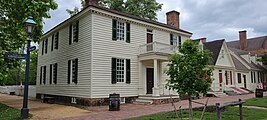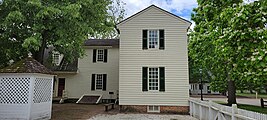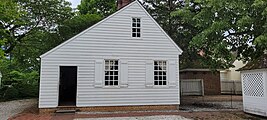|
Geddy House
The Geddy House, also known as the James Geddy House,[1] was built by James Geddy Jr. ca. 1762.[2] One of the oldest houses in Virginia and in Williamsburg,[3] it is located on the Palace Green across from Bruton Parish Church. It is a two-story, central-passage house.[4][5] HistoryJames Geddy Jr. was a well-established silversmith in Williamsburg.[6] Advertisements in the late 1760s indicate that Geddy's business sold imported silver and gold items, in addition to fine jewelry and cutlery.[7][8] In 1762, Geddy built the house at the corner of Duke of Gloucester Street and Palace Green.[9] In addition to serving as the family home, the structure also housed the various business ventures of the Geddy family utilizing a rear entrance as a retail shop.[6][10] During restorations of Colonial Williamsburg in 1930 and 1967, the entrance porch was replaced, and the house's chimneys were rebuilt above the roof ridge.[4] The house retains much of its original woodwork.[11] Further preservation activities were undertaken in 2002.[12] FeaturesMany aspects of the house's design are not common in other sites in Williamsburg.[13] The house's low-pitched roof and lack of dormers are unusual features, as are the door and balcony above the front porch. The L-shape may have also been adapted to fit the location.[4] The details of the home include English architecture and Italian variations of Greek and Roman architecture.[4][13] Archeological excavations of the shop site of the house have provided information about eighteenth-century clockmaking in British America.[14] Gallery
References
Wikimedia Commons has media related to Geddy House. |
||||||||||||||||||||||||||||||||||




